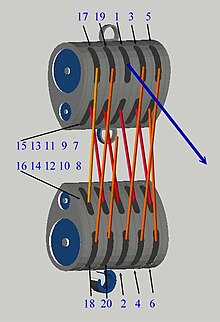Reeving

With reeving , for example, the hoisting rope of a - both the process and the manner referred to, in a rope threading roller blocks will crane in the rollers of roller head and hook block .
European reeving
With the so-called "European reeving", the hoist rope is first guided over a pulley on the far right (or left) outside over the pulley head. Then the rope is always reeved into the next roll to the left (or right).
American reeving
With the “American reeving”, however, the hoist rope is fed in the middle of the roll package. Then the rope is first reeved in one direction (e.g. to the right), whereby one role is always skipped both in the roller head and in the hook block. At the end, the rope is reeved in the shape of an 8 between the hook and the pulley head and then guided back to the middle in the pulleys that are still free. From there, the procedure is continued mirror-inverted in the other direction, until the rope is finally back in the middle and is also attached there. The advantage of this reeving is that the rollers wear more evenly and the rope package has less tendency to twist itself.
Prime examples
Leonardo's drawing as the origin with 20 rolls side by side
Reeving according to ABoK # 3254,
See also
literature
- Clifford W. Ashley: The Ashley Book of Knots . Over 3800 knots. How they look like. What they are used for. How they are made. Special edition. Edition Maritim, Hamburg 2005, ISBN 3-89225-527-X . Here: pp. 531, 532; ABoK # 3251-3260
Web links
- Reeving at Baumaschinen-Modelle.net
- Replica of a pulley system based on Leonardo da Vinci from the Codex Atlanticus with a special reeving.
- Illustration of different American pulley blocks including their designation
- American reeving on a triple block tackle




